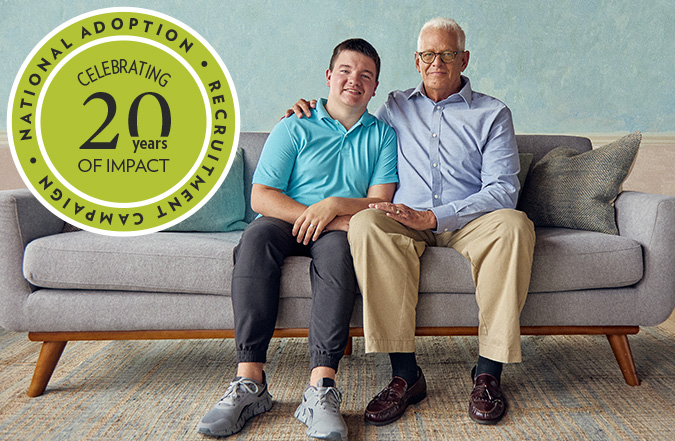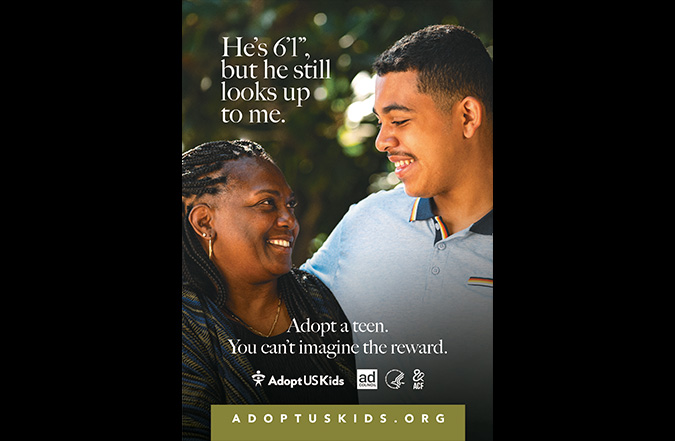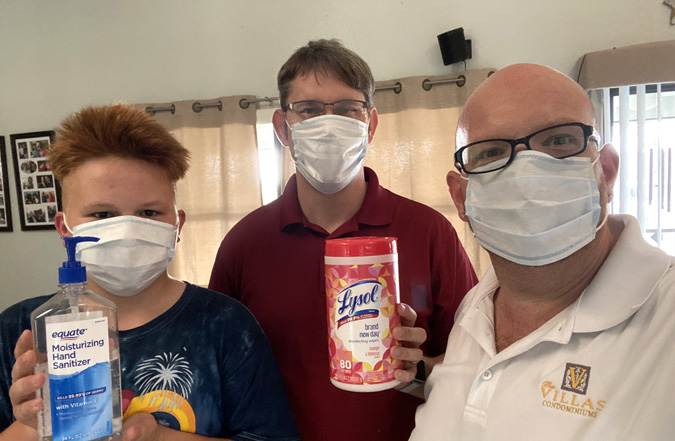
The Children’s Bureau, in partnership with the Ad Council and AdoptUSKids, formed a unique collaboration in 2004.
Now celebrating 20 years, the partnership continues to develop public service ads that highlight the need for more adoptive parents and the benefits of adopting from foster care.
The ads use various media, mixing both humor and heartfelt stories, and others feature authentic adoption stories to inspire prospective parents to consider adopting from foster care. Since the campaign’s launch in 2004, more than one million children and youth have been adopted from foster care. While it is impossible to determine the campaign’s direct impact on this total, data does show that people (age 21 and older) who have seen the ads are 3.5 times more likely to consider adopting from foster care than those unaware of the PSAs (Source: Ad Council commissioned research with Ipsos, 2017-2024).
“This campaign has always been about more than just numbers,” said Jane Morgan, former division director for capacity building at the Children’s Bureau. “It’s about having the national conversation and helping families see that they are capable of providing the love and care these children and youth need.”
The beginning of change
While the campaign was never truly about the numbers, it did start with statistics.
In 1993, a little more than 10 years before the partnership’s formation, a separate launch set in motion a series of events leading to the collaboration’s campaigns. That year marked the creation of the Adoption and Foster Care Analysis and Reporting System (AFCARS). For the first time, it allowed the meaningful collection of a wide range of data on those impacted by the child welfare system.
Shortly after, in 1997 the Adoption and Safe Families Act passed, facilitating the promotion of shorter timeframes for states to achieve permanency for children in foster care, which impacted the number of children in care and increased their opportunities for permanency.
In addition, the Child and Family Services Review (CFSR) was launched in 2000 to collect and provide insights into individual states’ systems. In 2002, AdoptUSKids was formed to offer the first national photolisting website.
Each of these individual components pointed to a need for collaborative action.
“We knew we had to do something big,” Morgan said. “For the first time, we had data—real numbers about who the children were and where they were and who was stepping up. And we also had a vision to connect them with families across the country (via the photolisting).”
Enter the Ad Council.
The Ad Council connected with the Children’s Bureau and AdoptUSKids to combine each partner’s unique expertise to create a national campaign to increase awareness of adoption from foster care and the need for more parents.
The Children’s Bureau provided data-informed insights to help identify the barriers that stopped people from adopting from foster care. The Ad Council offered its creative expertise and extensive media network to develop and disseminate the public service advertisements (PSAs). AdoptUSKids helped inquiring families get started with the process by providing accurate and helpful information about adoption and foster care and connecting families with their states for additional resources.
Changing the narrative
From the beginning, each partner understood that unlike many other adoption campaigns at the time, this campaign would explicitly feature older youth and speak directly to the mindset of prospective parents.
“The key insight from our research, particularly the in-depth conversations we held with prospective parents, revealed several barriers to consider, the most prominent was self-doubt. Many of these prospective parents feared failing a child who had already been failed before,” said Tony Foleno, SVP Insights & Analytics at the Ad Council. “They, like anyone considering parenthood, worried about being ‘good enough,’ underscoring how critical it was to acknowledge this concern head on.”
The first PSA series tackled this directly with the tagline, “You don’t have to be perfect to be a perfect parent.”
Additionally, at the time, most people associated adoption with infants, while these PSAs intentionally featured youth ages eight or older.
“We thought we were being courageous by featuring these kids, and at the time, we were,” Morgan said.
For the past two decades, the campaign has maintained its appeal to prospective parents, and it has only expanded the children and youth who are featured, including sibling groups, and teenagers, who often wait longer for adoption. Today, the campaign emphasizes the mutual benefits of adoption for parents and teens, encapsulated in the new tagline, “You can’t imagine the reward.”

Adoptive families, authentic stories
The youth featured in the PSAs has expanded during the last 20 years, as have the people enlisted to share the message.
Early ads were scripted and featured actors. One memorable example included a woman portraying a busy mom who seemingly vacuums up the family hamster, then neatly segueing to the tagline of, “You don’t have to be perfect to be a perfect parent.”
The campaign has since shifted from its humorous approach to one that is more heartfelt by featuring adoptive families instead of actors portraying adoptive families. Keeshann Jones of Lebanon, Ohio and her husband, James, traveled to Brooklyn, New York to appear in the 2024 PSA along with their adopted teenagers, Za’Quan and Princess, and praised the shift from using actors to portray families to featuring adoptive families.
“When I got there, I asked the director, ‘Do you want me to make this cushy? Or do you want me to be real-real?,” she said. “He told me to be real, so that’s what I did.”
By showcasing genuine lived experiences, Keeshann said that the PSAs can help demystify adoption from foster care and paint a more honest picture that better reflects the new tagline, “You can’t imagine the reward.”
“If we don’t share our stories, how will people know? These ads show the realness and the reward of adoption,” Keeshann said. “I truly believe that when people see families in action and hear their stories, it helps them understand the process and see themselves in it as part of the solution. And as the tagline says, you can’t imagine the reward. The reward is the love and care you both give and receive. The reward is watching a young person blossom, grow, and develop. Believe me when I say it’s amazing. Even when things are tough, you get to know you’re making an impact.”

Impact by the numbers
“Telling powerful stories to accelerate impact is core to the Ad Council’s mission. By maintaining a proven strategy to open hearts and inspire action, we are proud of the success and longevity of this campaign and the program’s ability to shed a light on the transformative power of adoption from foster care,” said Michelle Hillman, chief campaign development officer of the Ad Council.
Evaluation is a key component to all Ad Council campaigns, including the adoption from foster care campaign, which has a call to action unlike any other ask—to adopt from foster care. A strong research foundation and clear measurements of success were developed for the campaign that could demonstrate shifts in attitude, behavior, and awareness.
Throughout the last two decades, one shift shows up most significantly via a particular statistic. Tracking data shows that people who have seen the ads are 3.5 times more likely than those who have not to consider adoption from foster care (Source: Ad Council commissioned research with Ipsos, 2017-2024).
This increased awareness of adoption from foster care, alongside many other factors, has contributed to the adoption of more than one million youth from foster care in the 20 years since the campaign began.
Additionally, awareness of the campaign has increased by more than 20 percent, and the campaign has benefitted from more than $917 million in donated media support in the last two decades (Source: Ad Council commissioned research with Ipsos, 2011-2024).
“Data and research have been essential to the success of our national campaign, but equally important are the personal stories from families and youth that highlight the real, life-changing impact we’ve made. Our partnership with the Ad Council and AdoptUSKids continues to drive meaningful progress, and we remain committed to making a lasting difference for children and youth in foster care waiting for a loving, permanent family,” said Dr. Randi Walters, division director, Capacity Building, Children’s Bureau.
Learn more about adopting from foster care by browsing AdoptUSKids’ frequently asked questions.
View and share the 2024 national adoption recruitment campaign materials featuring the tagline, “You can’t imagine the reward.”


